|

Mongooses have long faces and bodies, small rounded ears, short legs and long tapering tails. Most are brindled or grizzled; few have strongly marked coats. They have non-retractile claws that are used primarily for digging.
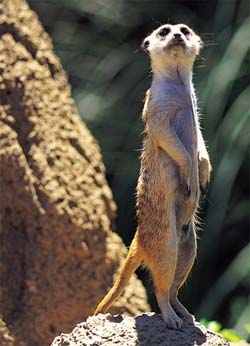 Weights and Measures: The meerkat is a small diurnal mongoose whose weight averages approximately 731 grams for males and 720 grams for females. Its long and slender body and limbs give it a body length of 25 to 35 cm and an added tail length of 17 to 25 cm. Its tail is not bushy like all other mongoose species, rather is long and thin and tapers to a pointed tip which is black or reddish colored. Weights and Measures: The meerkat is a small diurnal mongoose whose weight averages approximately 731 grams for males and 720 grams for females. Its long and slender body and limbs give it a body length of 25 to 35 cm and an added tail length of 17 to 25 cm. Its tail is not bushy like all other mongoose species, rather is long and thin and tapers to a pointed tip which is black or reddish colored.
Just the Facts: The meerkat uses its tail to balance when standing vertical. Its face also tapers, coming to a point at the nose, which is brown. The eyes always have black patches surrounding them which help deflect the sun's glare. The meerkat has small, black, crescent-shaped ears that have the ability to close when digging to prevent sand entering.
Claws and Fur: Meerkat have strong, 2 cm long, curved claw used for digging for prey and altering their underground burrow. They have four toes on each foot and long, slender limbs. The coat is usually fawn-colored peppered with gray, tan, or brown with a silver tint. They have short, parallel stripes across their backs, extending from the base of the tail to the shoulders, and unique to each animal. The underside of the meerkat has no markings but the belly has a patch which is only sparsely covered with hair and shows the black skin underneath. The meerkat uses this area to absorb heat standing on its rear legs, usually early in the morning after cold desert nights.
Meerkats eat mainly insects, but also lizards, snakes, spiders, plants, eggs and small mammals. Like all mongoose species, they are immune to many venoms, and eat scorpions (including the stinger) and some snakes, without fear of illness, poison or death. They have no fat stores, so foraging for food is a daily need.

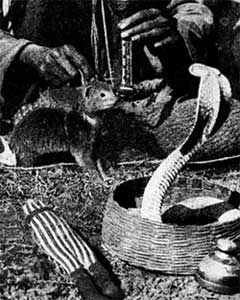 Meet My Mongoose! Some species of mongoose can be easily domesticated and trained. They are fairly intelligent and can be taught simple tricks, so they are often kept as pets to protect the home from vermin. However, they can be more destructive than desired; when imported into the West Indies for the purpose of killing rats, they destroyed most of the small, ground-based fauna. Meet My Mongoose! Some species of mongoose can be easily domesticated and trained. They are fairly intelligent and can be taught simple tricks, so they are often kept as pets to protect the home from vermin. However, they can be more destructive than desired; when imported into the West Indies for the purpose of killing rats, they destroyed most of the small, ground-based fauna.
It is illegal to import most species of mongooses into the United States, Australia and other countries. Mongooses were introduced to Hawaii in 1883, and have had a significant impact on native species. Mongooses are sometimes referred to as "the most dangerous animals on the planet" for this reason.
All in the Family: The meerkat or suricate (Suricata suricatta) lives in troops of 2-3 families each comprising a male, a female and 2-5 offspring in open country in Southern Africa (Angola, Namibia, Botswana, South Africa). Meerkats are small, diurnal mammals foraging for invertebrates in open country. Their behavior and small size (they weigh less than a kg) makes them very vulnerable to larger carnivores and birds of prey.
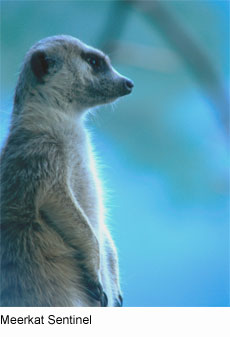
The Lookout: To protect the foraging troops from predators, one meerkat serves as a sentinel - climbing to an exposed vantage point and scanning the surroundings for danger.
If the sentinel detects a predator it gives a loud alarm call to warn the troop and indicate if the threat comes from the air or the ground. If from the air, the meerkats rush as fast as they can to the nearest hole.
If from the ground, the troop flees but not quite so fast as meerkats are more able to evade terrestrial predators than airborne raptors.
Social Butterflies: Meerkats are burrowing animals, living in large underground networks with multiple entrances which they leave only during the day. They are very social, living in colonies of up to about 40. Animals in the same group often groom each-other to strengthen social bonds.
The Alpha Pair: The alpha pair often scent-mark subordinates of the group to express their authority, and this is usually followed by the subordinates grooming the alphas and licking their faces. This behavior is also usually practiced when group members are reunited after a short period apart. Most meerkats in a group are all siblings and offspring of the alpha pair.
Babysitter's Club: Meerkats also babysit the young in the group. Females that have never produced offspring of their own often lactate to feed the alpha pair's young, while the alpha female is away with the rest of the group. They also protect the young from threats, often endangering their own lives. On warning of danger, the babysitter takes the young underground to safety and is prepared to defend them if the danger follows. If retreating underground is not possible, she collects all young together and lies on top of them.
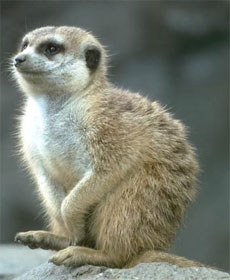 Family Feud: Despite this altruistic behavior, meerkats sometimes kill young members of their group. Subordinate meerkats have been seen killing the offspring of more senior members in order to advance their own offsprings' positions. Family Feud: Despite this altruistic behavior, meerkats sometimes kill young members of their group. Subordinate meerkats have been seen killing the offspring of more senior members in order to advance their own offsprings' positions.
Mongoose Vocabulary: It has recently been noted that meerkat calls may carry specific meanings, with specific calls alerting to the approach of snakes, birds of prey, or other predators. How these calls work is not clear. They are a demonstration that meaning is not solely the domain of human language, although the calls of the meerkat do not constitute a form of language.
Yodeling? More than one field researcher has reported witnessing meerkats in some sort of singing ceremony they compared with yodeling.

Meerkats become sexually mature at about one year of age and have, on average, three young per litter. Wild meerkats have up to three litters per year. Meerkats are iteroparous and can reproduce any time of the year but most births occur in the warmer seasons.
Reports show that there is no precopulatory display; the male fights with the female until she submits to him and copulation begins. Gestation lasts approximately 11 weeks and the young are born within the underground burrow and are altricial. The young's ears open at about 10 days of age, and eyes at 10-14 days, they are weaned around 49 to 63 days. They do not come above ground until at least 21 days of age and stay with babysitters near the burrow. After another week or so they join the adults on a foraging party.
Usually, the alpha pair reserve the right to mate and normally kill any young not their own, to ensure that their offspring has the best chance of survival. They may also exile or kill the mothers of the offending offspring.
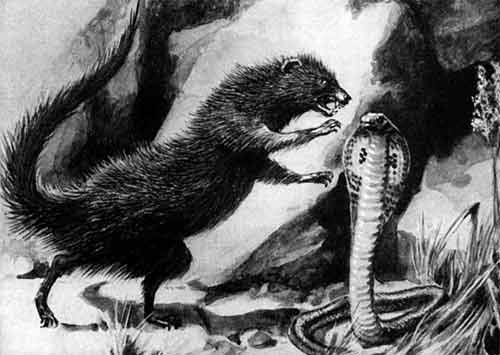
All text is available under the terms
of the GNU Free Documentation License
|